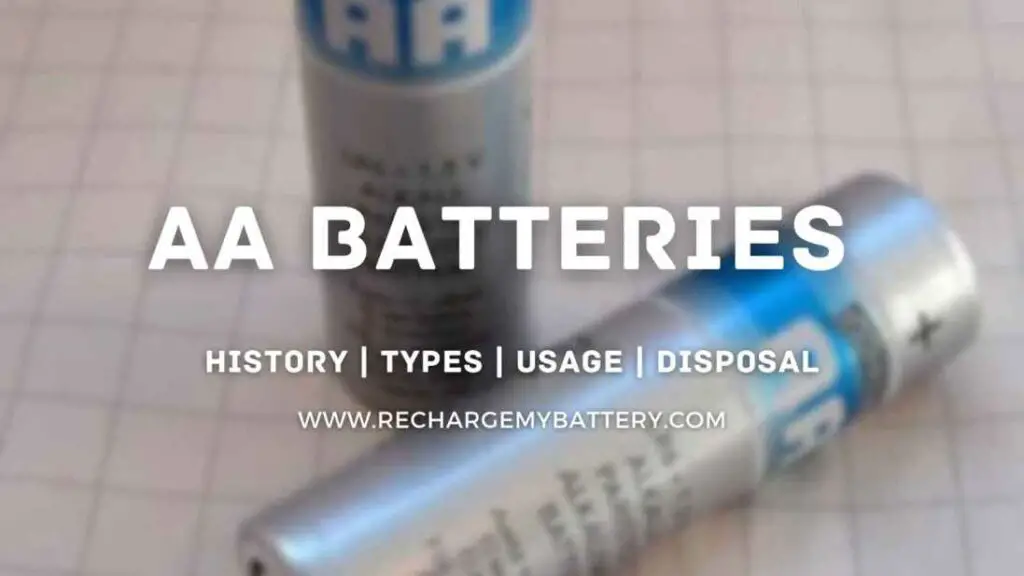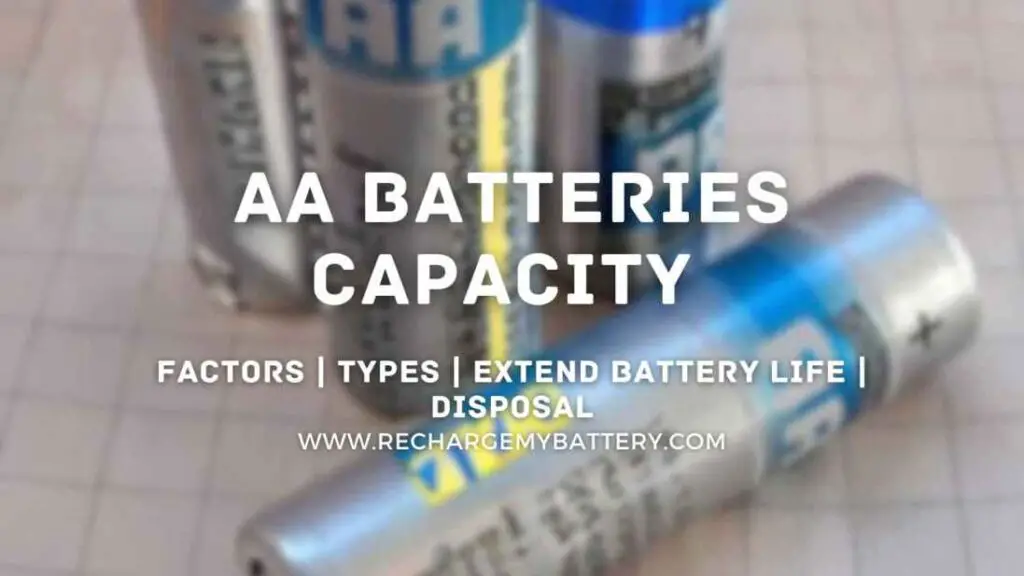The AA batteries are used to power up the devices like remote control, toys, cameras, flashlights, and more.
This article will cover the detailed knowledge you need about these AA batteries, which will include their history, type, chemistry, applications, ways to properly make use of them, and how to dispose of them.
What are AA Batteries?
These battery sizes come in the list of the most popular batteries in the world. These batteries are:
- Affordable
- Reliable
- Versatile
These can be used to lighten up many devices that are used in our daily lives like cameras, remote controls, flashlights, toys, and more. Let’s now start discussing all important information about these AA batteries, from their history to their proper usage and disposal.
History of AA batteries
In the early 20th century, when the popularity of flashlights and portable radios was growing. At that time, American Eveready Company introduced the first AA-sized battery in 1956. For large C and D batteries, the AA-sized battery was their successor.
This battery was small, lighter, and more suitable for the customers, but still not lacking to provide a decent amount of power. Since then, for ubiquitous household items and many devices, the standard size of these AA batteries had started to be used.
How do AA batteries work? (Types of AA Batteries)
The foundation of any AA battery lies in a sequence of chemical reactions that transform potential energy into electrical energy. There are typically three types of chemical compositions found in AA batteries:
- Alkaline
- Nickel-metal hydride (NiMH)
- Lithium
- Zinc-Carbon
Each of these compositions possesses its own unique advantages and disadvantages in terms of cost, performance, and environmental impact.
1. Alkaline
Alkaline batteries contain:
- Zinc powder anode
- Manganese dioxide cathode
- Potassium hydroxide solution electrolyte
As soon as a device connected to the battery is activated, the battery starts to discharge and a current flows through it. At the anode, zinc atoms undergo oxidation, which generates zinc ions and electrons. The electrons travel through the device to provide power, while the zinc ions react with hydroxide ions present in the electrolyte, producing zinc oxide and water.
At the cathode, the manganese dioxide accepts the electrons and in conjunction with protons and water from the electrolyte, forms manganese oxide and potassium ions.
All of these chemical reactions work together to enable the conversion of potential energy into electrical energy.
2. Nickel-metal hydride (NiMH)
Nickel-metal hydride (NiMH) batteries use a hydrogen-absorbing alloy anode and a nickel oxyhydroxide cathode, along with an electrolyte solution that is usually composed of potassium hydroxide or a mixture of potassium and lithium hydroxide.
When the device is turned on, a current flows through the battery, which releases hydrogen ions from the anode. These ions then react with oxygen ions from the cathode to create water, releasing electrons in the process. The electrons flow through the device, providing power.
Meanwhile, hydroxide ions from the electrolyte combine with nickel ions from the cathode to create nickel hydroxide. This process of conversion of chemical energy into electrical energy allows NiMH batteries to power various electronic devices efficiently.
3. Lithium
Lithium batteries are composed of a:
- A lithium metal or alloy anode
- A cathode made of lithium-based material such as lithium cobalt oxide or lithium iron phosphate
- An electrolyte solution, which usually contains a lithium salt dissolved in an organic solvent or polymer gel.
When the device is turned on, current flows through the battery and lithium ions from the anode migrate through the electrolyte toward the cathode. There, they combine with electrons and the cathode material to produce lithium compounds. This process releases energy and powers the device.
Meanwhile, electrons flow through the device, providing electrical power. As the device is used, lithium ions from the cathode migrate back to the anode to maintain the electrochemical balance of the battery.
The high energy density and long lifespan of lithium batteries make them a popular choice for portable electronic devices, such as smartphones and laptops.
4. Zinc-Carbon
Zinc-carbon batteries were once a popular choice for low-power devices such as:
- Flashlights
- Radios
- Smoke detectors
However, they have been largely superseded by alkaline batteries due to their shorter lifespan and tendency to leak if left unused for prolonged periods.
These batteries have a voltage of 1.5V and a capacity of around 1000-1500 mAh, depending on the brand and how they are used.
Despite their limitations, zinc-carbon batteries can still be suitable for devices that require intermittent use and do not demand a lot of power.
Applications of AA batteries
AA batteries are versatile power sources that find their way into an extensive range of household items and professional equipment. They are a popular choice for many devices due to their small size, portability, and convenience. Below are some of the most common applications of AA batteries:
Toys and games
One common application of AA batteries is in toys and games, particularly those designed for kids, such as dolls, remote-controlled cars, robots, and electronic games.
Remote controls
Another popular use of AA batteries is in remote controls for TVs, DVD players, and audio systems, which power their infrared signals. While some remote controls may also use AAA or button cell batteries, AA batteries are still the preferred choice for many manufacturers.
Flashlights
For outdoor enthusiasts, AA batteries are a must-have for flashlights. These handheld devices offer a reliable source of light during power outages, camping trips, or hiking adventures.
Cameras
Many point-and-shoot digital cameras use AA batteries, which allow for greater flexibility and convenience when traveling to remote locations where access to electricity may be limited.
Wireless mice and keyboards
Wireless computer accessories, such as mice and keyboards, also make use of AA batteries. This design enables greater mobility and ease of use without the need for a wired connection to the computer.
Smoke detectors
Smoke detectors in homes and commercial buildings often use AA batteries to ensure that they remain operational even in the event of a power outage.
With these reliable power sources, the detectors can keep working and protect people from potential fire hazards.
Proper use and disposal of AA batteries
Using and disposing of AA batteries correctly is crucial to ensure proper performance and safety. Here are some tips to keep in mind:
Using the correct type of battery
It is important to use the correct type of AA battery for your device, as specified by the manufacturer. Using the wrong type of battery can lead to reduced performance or even damage to the device.
Storing batteries properly
Store AA batteries in a cool, dry place, away from direct sunlight and heat sources. Extreme temperatures or humid environments can reduce their lifespan and performance.
Avoid mixing old and new batteries
Mixing old and new batteries or different types of batteries in the same device can lead to reduced performance and even leakage.
Properly disposing of batteries
It is crucial to follow local regulations and guidelines when disposing of AA batteries. Many areas have designated recycling centers or hazardous waste facilities where batteries can be safely disposed of. This helps to reduce environmental impact and potential harm to human health.
Conclusion
In today’s world, AA batteries have become an essential part of our lives as they are used to power various devices ranging from toys to professional equipment.
Being aware of the different types of AA batteries and their applications, as well as the correct way to use and dispose of them, is crucial to ensure optimal performance and safety.
Whether you’re out camping or simply lounging at home, AA batteries play an important role in keeping your devices running smoothly and keeping you connected to the world around you.
Thank you for reading this article.
FAQs
Q1. Can AA batteries be recycled?
It is important to dispose of batteries properly to prevent harmful chemicals from entering the environment and to conserve valuable resources that can be recovered through recycling.
Q2. Can I use rechargeable batteries in place of alkaline batteries?
Q3. Can AA batteries leak if left unused for a long time?
In order to prevent this, it is recommended to store unused batteries in a cool, dry place that is away from direct sunlight and sources of heat. This can help to prolong the lifespan of the batteries and prevent any potential damage or leakage.
Q4. How long do AA batteries last?
It’s important to check the manufacturer’s specifications for the battery lifespan and recommended usage to ensure optimal performance and longevity.

